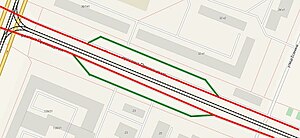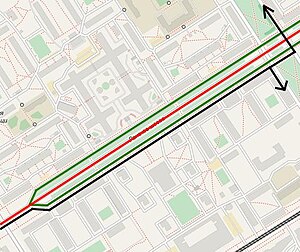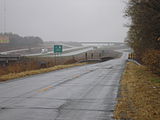Key:side_road
 |
| Description |
|---|
| tag for marking side carriageways of roads. |
| Group: highways |
| Used on these elements |
| Useful combination |
|
| Status: undefined |
| Tools for this tag |
|
The key side_road (Russian: боковой проезд) is used to mark the side carriageways of roads. These are not the same as frontage roads – tag those with frontage_road=yes. Please remember that they may not exist in every city or country!
Description
In this description, "side road" (Russian: боковой проезд) is a separate carriageway of a road which usually, but not necessarily, is located next to the main carriageway and begins after one crossing and ends before the next crossing. The principal difference from a trafficway, which acrosses the adjoining territory (Russian: прилегающая территория) is acceptance of transit movement[1]. A side road can be both a one-way street and a two-way street. It can have traffic signs, restricted maximal speed, pedestrian crossing (Russian: пешеходный переход) and traffic lights.
On the one hand, transit traffic through a side road is not prohibited – so routing through a side road using navigation software does not contradict traffic rules[1]. On the other hand, entering a side road may require lane changing, reducing speed, and when returning to the main carriageway, yielding to cars moving along it. Therefore, driving on side roads should be avoided whenever possible.
The need to distinguish side roads from main carriageways may also arise, for example, when binding tracks to roads. To indicate that the carriageway is such a side road - pocket (Russian: боковой проезд - карман) add side_road=yes (if there are trafficways, connecting side_road with main carriageway), side_road=double (if the side road is a full-fledged double for the main carriageway) or side_road=rotary (if the side road is used for turning to an intersecting or adjoining road because turning from the main carriageway is physically impossible or prohibited). Additionally, the tag highway=residential can be used for side roads near apartments, and highway=unclassified for side roads near factories.
Sometimes it is impossible to avoid using side roads, as some of them are used for maneuvers that are prohibited on the main road. Roads that are only connected to a side road, but not the main carriageway, may also exist. In such cases, the status of side road can be any. (highway=tertiary, highway=secondary etc.). There are different opinions about using the tag name=* for side roads: some people think it is acceptable, while others believe it is not.
Terminology
In relation to this type of road, terms such as "pocket" (Russian: карман), "branch" (Russian: рукав), or "small side way" (Russian: боковая дорожка) may also be used. It is important to distinguish side roads, about which we are talking in this page, (Russian: карман) from side roads mentioned in traffic regulations (Russian: карман)[1], which are widened parts of the road used for stopping and/or parking.
In the United States, these roadways are called "frontage lanes" or "frontage roads". However, not all frontage roads can be tagged with side_road=yes. For example, in Texas, many urban freeways feature substantial frontage roads that are distinct from the ones described on this page.
Tagging
In addition to the tag side_road=* it is useful to use additional tags such as maxspeed=* to provide more information about the road, just as it is done with other types of roads.
The side_road tag itself does not automatically impose restrictions; it is used to mark carriageways that are not central (onsetter): lateral ways (Russian: боковые проезды), side roads (Russian: карманы) and driveways that connect central carriageways with lateral carriageways.
Examples
- Examples from Russia
-
Classical side roads (Russian: карманы) in Saint Petersburg. Red lines represent main carriageways, green lines represent side roads, tagged with side_road=yes
-
Adjacent roads (blue lines) connect only to a side road (Russian: карман, green line, tagged as side_road=rotary). There is no direct connection to the main carriageways (red lines).
-
It is possible to make turns (black lines) only from the side roads (Russian: карманы, green lines, mapped as side_road=rotary). Turns from main carriageway (red line) are prohibited.
-
The side road (green line, tagged as side_road=double) runs independently of the main carriageway (red line). We can consider side roads as full-fledged duplicate (Russian: дублёр).
- Examples from the United States
-
This frontage road along a rural freeway in Missouri (locally called an outer road) does not connect directly to the freeway and even dead ends in some places.
highway=residentialorhighway=unclassified
Notside_road=*
External links
- Forum discussion (in Russian)
References
- ↑ 1.0 1.1 1.2 in Russian Federation








